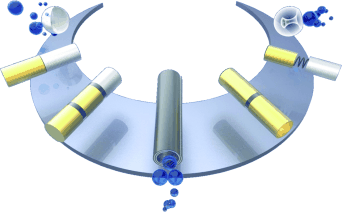Chemically driven micro- and nanomotors

At least since the movie "The Fantastic Voyage" in 1966, in which a submarine is shrunk down and injected into the blood stream of a human, people have been toying with the idea of sending tiny "micromachines" and "nanorobots" into our organs or individual cells to carry out delicate "repairs". This is now beginning to approach the realm of possibility. In the journal Angewandte Chemie, scientists from Stuttgart present the current state of research in the area of catalytic micro- and nanomotors.
In order for tiny motors to move around, they can be driven externally, by means of electric or magnetic fields or ultrasound. "Self-propelled micro- and nanomotors can operate autonomously, driving themselves by means of catalytic reactions in liquids, for example," explain Samuel Sánchez and his co-authors from the Max Planck Institute for Intelligent Systems in Stuttgart in their review article. "Remote controlled nanomotors can transport cargo to desired targets, drill into biomaterials, sense their environment, mix or pump fluids, and clean polluted water," says Sánchez. At this point in time, the scientific goals are to find the best architecture for self-propulsion, to understand propulsion mechanisms, and to achieve very precise control over movement. In addition, the search for biocompatible fuels and drive mechanisms is of primary importance.
Purely synthetic micro- and nanomotors usually take the form of nanowires, nanospheres, or nanotubes. Nanowires made from combinations of different metals can be driven by self-electrophoresis, in which they move in a self-induced electric field resulting from an asymmetrical distribution of ions. Also interesting are nanospheres with two different hemispheres. This allows one half to be coated with a catalyst that causes an asymmetrical distribution of a reaction product, which moves the spheres along. Jet-shaped micro- or nanotubes whose interiors are coated with a catalyst are particularly versatile and efficient when they are driven by bubbles: a catalytic reaction occurs inside the tubes, forming a gas—usually oxygen—that exits the wider opening in the form of bubbles, pushing the jet along. The "fuel" is usually hydrogen peroxide. Immobilized, the jets can also function as micropumps for use in applications such as microfluidic diagnostic and analytical chips.
In the field of biomedicine, the wish list includes micromotors that can selectively drill into tumor cells and destroy them. Self-propelled nanotransporters could carry drugs selectively to diseased organs. Other potential applications include the field of environmental remediation. "Micromotors with a hydrophobic coating could trap oil droplets in contaminated water and carry them away. Others could break down organic pollutants in water while actively mixing the solution." reports Sánchez.
More information: Chemically Powered Micro- and Nanomotors Angewandte Chemie International Edition dx.doi.org/10.1002/anie.201406096
Journal information: Angewandte Chemie , Angewandte Chemie International Edition
Provided by Angewandte Chemie




















